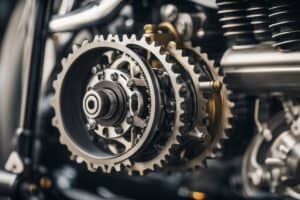Experiencing issues with your motorcycle speedometer can be more than just a nuisance; it’s a safety concern and a buzzkill for your riding experience.
Whether it’s giving erratic readings or has stopped working entirely, you’re likely looking for a fix that gets you back on the road swiftly.
Luckily, troubleshooting a faulty speedometer doesn’t have to be a trip to the mechanic.
With a few tools and some patience, you can diagnose and often repair the problem yourself.
Let’s gear up and get your speedometer back in check.
Causes of a faulty motorcycle speedometer
When your motorcycle speedometer isn’t working correctly, several culprits could be to blame.
Understanding these causes is essential for a successful DIY repair.
Damaged or Disconnected Cables are often the root of the problem.
Your motorcycle’s speedometer cable rotates within a casing and connects the speedometer to the gearbox.
If this cable breaks or becomes disconnected, the speedometer won’t receive the necessary information and can’t display the correct speed.
Faulty Speed Sensors are another common issue, especially in modern motorcycles with digital speedometers.
These sensors replace traditional cables and can malfunction due to dirt build-up or wear and tear, sending incorrect signals to the speedometer.
- Electromagnetic Interference can disrupt the electrical components of your motorcycle, leading to Erratic Speedometer Readings.
Nearby magnetic fields from other electronic devices can affect the sensor’s accuracy.
Wear and Tear over time affects all mechanical components.
Gears within the speedometer can wear down, causing inaccuracies or non-responsiveness in the gauge.
Exposure to the Elements such as water, dirt, or extreme temperatures can cause internal components to corrode or malfunction.
This exposure is especially problematic for motorcycles that aren’t regularly maintained or are often used in harsh conditions.
Regular maintenance and prompt repairs when you spot the first sign of trouble will help prevent more extensive issues with your speedometer.
Keep an eye out for these common problems and tackle them quickly to ensure your safety on the road.
Tools needed for troubleshooting
When you’re facing issues with your motorcycle speedometer, it’s crucial to have the right tools at your disposal to effectively troubleshoot the problem.
Start by gathering a multimeter, which is indispensable for testing electrical connections and assessing the health of your speedometer circuit.
Whether it’s a digital or analog multimeter, ensure you’re comfortable using it to check for continuity and voltage variations.
Next, you’ll need a set of screwdrivers.
These should include both flathead and Phillips head varieties to match the screws typically found on motorcycle panels.
With these, you can easily access the speedometer and its associated components.
Don’t forget a good pair of pliers and some wrenches.
You’ll often need these to loosen and tighten the nuts and bolts that secure the cables and sensors in place.
Adjustable wrenches offer flexibility for different sizes, whereas a socket set could be invaluable for hard-to-reach areas.
Additionally, have some contact cleaner on hand to clean electrical contacts and remove any build-up that might interfere with the speedometer’s functionality.
A clean connection can often resolve intermittent issues.
Lastly, keep zip ties and electrical tape nearby.
After your maintenance or repairs, these will help you secure cables and wiring, ensuring they are neatly tucked away and safe from potential damage.
Step 1: Checking the wiring connections
When tackling a faulty motorcycle speedometer, start by examining the wiring.
Issues often originate from simple disconnections or loose wires.
First, you’ll want to locate your speedometer’s wiring harness—this is typically found behind the instrument panel.
Once you’ve accessed the wiring, follow these steps:
- Inspect each wire carefully for signs of fraying or damage.
- Ensure all connections are secure and intact, especially where wires meet the speedometer and sensor.
- If you come across any disconnected cables, reconnect them firmly.
- Should you find damaged wires, consider replacing them or applying electrical tape for a temporary fix.
Look for any signs of corrosion on the terminals as this can impede signal transmission.
If corrosion is present, use contact cleaner to remove it.
Double-check that the ground wire—that’s usually the black one—is properly connected to a clean, paint-free metal surface.
Poor grounding can also lead to inaccurate readings or a non-functional speedometer.
After you’ve scrutinized the wiring and made any necessary repairs, it’s time to test the speedometer.
Power up your motorcycle and take a look at the speedometer.
If the issue persists, you’ll need to delve deeper into the speedometer components, which could mean looking into the speed sensor or the internal mechanism of the speedometer itself.
Remember, meticulous troubleshooting is crucial in identifying the root cause of any speedometer malfunction.
Keep your workspace organized and your tools within reach to streamline the process.
Step 2: Testing the speed sensor
Once you’ve confirmed the wiring is intact and connections are secure, the next step is to zero in on the speed sensor.
This sensor is crucial as it measures the rotation of the motorcycle’s wheel, sending data to the speedometer.
Faults in the speed sensor can often cause a malfunctioning speedometer.
To begin, locate your motorcycle’s speed sensor, which is typically found on the front wheel hub.
Carefully disconnect the sensor and inspect it for damage or dirt which could interfere with its function.
You should clean the sensor thoroughly with an electrical contact cleaner.
After cleaning, use a multimeter to test the sensor’s functionality.
Set the multimeter to ohms and connect it to the sensor’s terminals.
A healthy sensor will show a certain resistance level indicated in your motorcycle’s service manual.
Next, set the multimeter to the AC voltage setting.
With the sensor connected, spin the wheel; you’re looking for a voltage reading that changes with the rotation.
If the voltage doesn’t fluctuate, it’s a strong indicator that the sensor isn’t working as it should.
In the event the sensor fails your multimeter test, replacing it is usually the best course of action.
Ensure that you obtain the correct replacement part by referencing your bike’s model and make specifications.
Installing the new sensor is a reverse process—mount it, reconnect the wiring and make sure it’s properly aligned.
It’s essential to remember that the speed sensor is a key player in the speedometer’s operation.
Issues here could ripple through to other elements in the system, which means getting the sensor’s functionality right is paramount to sorting out your speedometer troubles.
Step 3: Inspecting the speedometer cable
After ensuring the speed sensor’s functionality, turn your attention to the speedometer cable—a common culprit when it comes to speedometer issues.
Your bike’s model will dictate whether you have a mechanical or electronic speedometer; if it’s mechanical, it will have a cable.
First, you’ll need to locate the speedometer cable.
You’ll typically find it connected to the speedometer at one end and the front wheel or transmission at the other.
Once located, check for any visible signs of wear or damage.
Look for kinks, frays, or breaks in the cable that could be causing your speedometer problems.
Here’s how to properly inspect the cable:
- Disconnect the cable at both ends.
- Inspect the inner cable and the housing.
The inner cable should slide out easily—if there’s resistance, that’s a sign of trouble.
- Lubricate the cable with a suitable cable lubricant if it’s sticking or if you notice any dryness.
If the cable appears damaged or worn, replacing it is your best bet.
Make sure you obtain the correct length and type for your motorcycle.
When installing the new cable, avoid bending it sharply, as this could lead to premature wear or breakage.
Once installed, retest your speedometer to see if the issue has been resolved.
Remember, a properly functioning speedometer is not only crucial for staying informed about your speed but also for maintaining a safe ride.
Keep up with regular maintenance to prevent future speedometer troubles.
Step 4: Calibrating the speedometer
After inspecting and possibly replacing the speed sensor or speedometer cable, it’s crucial to ensure your motorcycle’s speedometer reads accurately.
Calibration is a straightforward process but essential for performance and compliance with traffic laws.
Start by referencing your motorcycle manual for specific calibration instructions.
Manufacturers often provide a calibration factor or a particular procedure to follow.
If you’ve replaced parts with non-OEM components, or if you’re switching to aftermarket tires with a different size profile, recalibration becomes even more important.
First, find a long, straight, and traffic-free road or use a motorcycle dynamometer.
You’ll need to establish a known speed reference point; this could be a GPS device or a road with accurate speed markings.
Ride at a steady speed as indicated by your reference point, and compare it to what’s shown on your motorcycle’s speedometer.
If the readings differ, most digital speedometers have a menu-driven calibration feature.
Enter the settings, adjust the calibration values according to your manual’s guidelines, and test again.
For analog speedometers, mechanical adjustments may be necessary.
This typically involves turning a screw on the back of the speedometer to achieve the correct reading.
Test your calibration at different speeds to ensure accuracy across the range.
Remember, varying factors like tire pressure, wear, or loading can influence your speedometer’s accuracy, so it’s wise to check periodically to maintain correct readings.
Assessing and adjusting your motorcycle’s speedometer calibration is key to ensuring a reliable readout.
Whether cruising through the city streets or throttling on the highways, a well-calibrated speedometer will keep you informed and within legal speed limits.
Regular checks are part of responsible motorcycle maintenance and contribute to a safer riding experience.
Frequently Asked Questions
What should I check first when troubleshooting a motorcycle speedometer?
Firstly, check the wiring connections for any signs of damage or disconnections, and ensure all connections are secure.
Also, look for corrosion and verify proper grounding.
How do I test a speed sensor?
Locate the speed sensor and inspect it for damage or dirt.
Then, use a multimeter to test the sensor’s functionality.
If it fails, replace it with the correct part.
What should I do if I find damage on the speedometer cable?
If the speedometer cable is visibly damaged or worn, disconnect it at both ends, inspect thoroughly, and lubricate if necessary.
If damage is confirmed, replace it with one that is the correct length and type for your motorcycle.
Why is calibrating the speedometer important?
Calibrating the speedometer is essential for accurate readings, compliance with traffic laws, and ensuring a safer riding experience.
It should be done according to the motorcycle manual, using a known speed reference, and periodically checked for accuracy.
As an Amazon Associate we earn from qualifying purchases.










